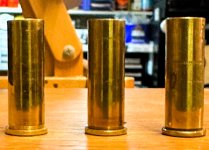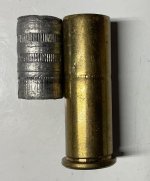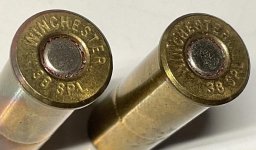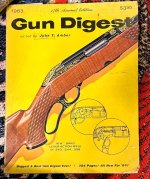-
Forum Update: We've upgraded the software to improve security, performance, and the overall experience.
👉 Read why we made the change | Support the Forum
You are using an out of date browser. It may not display this or other websites correctly.
You should upgrade or use an alternative browser.
You should upgrade or use an alternative browser.
,38 Special Cannelures Question
- Thread starter AJ
- Start date
Register to hide this ad
Alk8944
US Veteran
They are principally for identification of the load. Example: a 125 Gr. JHP, a 147 Gr. JHP and 158 Gr. JHP in a smooth case would look identical. The case cannelures allow identification once the ammunition is out of the box. Same with DEWC and HBWC loads. They are not universal between manufacturers.
The cannelures do not indicate any differences in the cartridge case itself.
For re-loaders the cannelure patterns can be ignored unless the individual wishes to segregate empty cases by this feature. One example is some re-loaders wish to load wad-cutter ammunition in cases originally factory loaded as wad-cutters. The cannelures, normally three in this case, allow identification of those cases that were factory wad-cutter loads.
The cannelures do not indicate any differences in the cartridge case itself.
For re-loaders the cannelure patterns can be ignored unless the individual wishes to segregate empty cases by this feature. One example is some re-loaders wish to load wad-cutter ammunition in cases originally factory loaded as wad-cutters. The cannelures, normally three in this case, allow identification of those cases that were factory wad-cutter loads.
Last edited:
SGT ROCK 11B
Member
If you look at Hornady factory 38 Special loaded with XTP bullets. The 125 XTP and 158 XTP look identical so the cannelure will let you know if it is the 125 or 158.
Check out the Bullseye-L Forum there is a lot of information about this issue. I have read some info about the old 148 HBWC factory ammo used the brass with the cannelure like shown in your photos. If you measure that style brass it has thinner case walls which works best with that style of bullet. Some really serious target shooters have shown that that style of brass helps with accuracy for bullets with that style of bullet.
The “match grade” wadcutter brass is an old myth.
I have a Bullseye friend who shoots pretty well. His .22 and .45 scores are in the 840-850 range. His Centerfire scores, however, rarely break much over 700. He insists on shooting his worn out model 52. He reloads for it most of the time, but shoots Winchester factory wadcutter 148 HBWC ammo for special matches.
Many years ago, we ran his 52 and and bunch of his ammo using the National Guard team’s Ransom Rest. His best groups ran about 3+ inches at 50 yds. Not good!
He gave me a few of his treasured Winchester factory rounds to pull down. This is the plain brass case stuff with the cannelure.
“Well, look at that!”
Not only did the base of the bullets sit below the cannelure, but the entire lower portion of these HBWC bullets were ruined! Look at the pictures! The lowest portion of the bullet skirt is stripped because of the cannelure. Not only that, but you can see shavings sheared off the edge of the base!
Way to go, Winchester!!
Once upon a time, the cannelure was rolled just below where the base of the bullet sits. I guess the guys at the factory don’t know why they use a cannelure either?
Admittedly, though, a 45 Long Colt with a 255 gr. LRN and a heavy cannelure looks pretty cool, in a retro cowboy way. If that matters….
I have a Bullseye friend who shoots pretty well. His .22 and .45 scores are in the 840-850 range. His Centerfire scores, however, rarely break much over 700. He insists on shooting his worn out model 52. He reloads for it most of the time, but shoots Winchester factory wadcutter 148 HBWC ammo for special matches.
Many years ago, we ran his 52 and and bunch of his ammo using the National Guard team’s Ransom Rest. His best groups ran about 3+ inches at 50 yds. Not good!
He gave me a few of his treasured Winchester factory rounds to pull down. This is the plain brass case stuff with the cannelure.
“Well, look at that!”
Not only did the base of the bullets sit below the cannelure, but the entire lower portion of these HBWC bullets were ruined! Look at the pictures! The lowest portion of the bullet skirt is stripped because of the cannelure. Not only that, but you can see shavings sheared off the edge of the base!
Way to go, Winchester!!
Once upon a time, the cannelure was rolled just below where the base of the bullet sits. I guess the guys at the factory don’t know why they use a cannelure either?
Admittedly, though, a 45 Long Colt with a 255 gr. LRN and a heavy cannelure looks pretty cool, in a retro cowboy way. If that matters….
Attachments
Last edited:
The double cannelure brass if Winchester, WW or Remington, RP or Peters shows it was originally sold as 38 special flush wadcutter ammunition. The single cannelure if Hornaday or Federal was also wadcutter brass. I have always found better accuracy with sorted brass and I keep the cannelured and non cannelured separate. I believe originally the cases were thinner from the cannelure forward.
AJ
US Veteran
Many years ago, we ran his 52 and and bunch of his ammo using the National Guard team’s Ransom Rest. His best groups ran about 3+ inches at 50 yds. Not good!
He gave me a few of his treasured Winchester factory rounds to pull down. This is the plain brass case stuff with the cannelure.
“Well, look at that!”
Not only did the base of the bullets sit below the cannelure, but the entire lower portion of these HBWC bullets were ruined! Look at the pictures! The lowest portion of the bullet skirt is stripped because of the cannelure. Not only that, but you can see shavings sheared off the edge of the base!
Way to go, Winchester!!
Once upon a time, the cannelure was rolled just below where the base of the bullet sits. I guess the guys at the factory don’t know why they use a cannelure either?
The factory spec's for the 52 were 2 inches at 50 yards. Maybe it is the ammo or try to get it rebuilt. Or find another and buy it. Most are not abused.
I don't think the "stripping" will hurt accuracy. That will get reformed by the lands & grooves as it moves down the barrel after being fired. The same with the base.
I am not good enough to shoot a two inch group off hand at 50 yards anymore. Will have to get the Ransom Rest out to find out
Many years ago Gil Hebard did extensive testing of the model 52. His conclusion was that a different diameter bullet was needed to shoot to the accuracy needed for bullseye competition. This information was shown in his catalog where sizing dies were shown for sale. He also had a report that he would send out to inquiring minds.
rockquarry
Member
- Joined
- Aug 9, 2005
- Messages
- 8,498
- Reaction score
- 10,429
Many years ago Gil Hebard did extensive testing of the model 52. His conclusion was that a different diameter bullet was needed to shoot to the accuracy needed for bullseye competition. This information was shown in his catalog where sizing dies were shown for sale. He also had a report that he would send out to inquiring minds.
A very interesting article. I haven't read it in a long time, but it was published in the 1963 GUN DIGEST and again in Hebard's PISTOL SHOOTER'S TREASURY. I've only had one Model 52 and .358" (actual sized diameter, .3575") bullets were noticeably more accurate than bullets sized smaller. Based on my limited Model 52 experience, I'd guess the best bullet diameter may vary a little from one gun to another.
gwpercle
Member
The cannelures on cases served a bullet holding purpose in the factory loadings ... I remember the 38 special rounds the police carried in their belts was usually nickel plated , two cannelure w/ lead round nose ammo ... the officer told me the two cannelures were to hold the bullets securely in place , that explanation sounded good 50 years ago ... Target Wadcutter factory ammo also has a cannelure (or two) ... and that is to hold the soft lead HBWC bullet and keep it from creeping forward or moving backward during shooting ... crimping those bullets can deform them . Pressing a cannelure around them is less damaging to the soft bullet .
They are simply bullet grippers and once fired ... their job is done ...
Ignore them when you reload the cases ... I just treat them as regular smooth sided cases .
Gary
They are simply bullet grippers and once fired ... their job is done ...
Ignore them when you reload the cases ... I just treat them as regular smooth sided cases .
Gary
Last edited:
AJ
US Veteran
Many years ago Gil Hebard did extensive testing of the model 52. His conclusion was that a different diameter bullet was needed to shoot to the accuracy needed for bullseye competition. This information was shown in his catalog where sizing dies were shown for sale. He also had a report that he would send out to inquiring minds.
A very interesting article. I haven't read it in a long time, but it was published in the 1963 GUN DIGEST and again in Hebard's PISTOL SHOOTER'S TREASURY. I've only had one Model 52 and .358" (actual sized diameter, .3575") bullets were noticeably more accurate than bullets sized smaller. Based on my limited Model 52 experience, I'd guess the best bullet diameter may vary a little from one gun to another.
Thanks for jogging my memory. I looked in my "library" and guess what I found. Will read Gil Hebard's article and the accompanying handloading article on . 38 Special for the 52 by Kent Bellah.
Attachments
Last edited:
rockquarry
Member
- Joined
- Aug 9, 2005
- Messages
- 8,498
- Reaction score
- 10,429
Thanks for jogging my memory. I looked in my "library" and guess what I found. Will read Gil Hebard's article and the accompanying handloading article on . 38 Special for the 52 by Kent Bellah.
I've probably read the Kent Bellah article but don't recall it at the moment. Certainly one of the better handgun writers of the '50s and '60s.
On some of my brass cases, the single high "Can" is on a lot of cases that
were loaded with the old style 110 & 125 gr Win & Rem, lead tip, copper jacket bullets.
The low, double "Can" cases were usually loaded with a 148 gr HBwc design,
but there are always exceptions to these rules.
were loaded with the old style 110 & 125 gr Win & Rem, lead tip, copper jacket bullets.
The low, double "Can" cases were usually loaded with a 148 gr HBwc design,
but there are always exceptions to these rules.
muzzlestuffer2012
Member
- Joined
- Feb 24, 2022
- Messages
- 306
- Reaction score
- 183
I just bought a 52-2 and been reading up and watching some pretty interesting videos pertaining to cannelures the one cannelure type keeps the wad cutter from going deeper into the case which can cause pressure spikes and the cases that have two the second upper most cannelure kept the wadcutter in the case longer for more uniform and full powder ignition there is even a test where they put a matching cannelure on the bullet that lines up with the case and it's pretty amazing on the accuracy increase.
- Joined
- Apr 4, 2006
- Messages
- 19,307
- Reaction score
- 30,228
When I first started out in reloading 45 years ago I would separate the cases in categories of brand, cannelure style and brass or nickel color. It did not take long for me to realize that was pretty much as waste of time and made zero difference! I now only separate brass from nickel - just because a full box of one or the other looks better.
Like others above have said, the cannelure is only used when originally loaded for a specific bullet.
Like others above have said, the cannelure is only used when originally loaded for a specific bullet.





